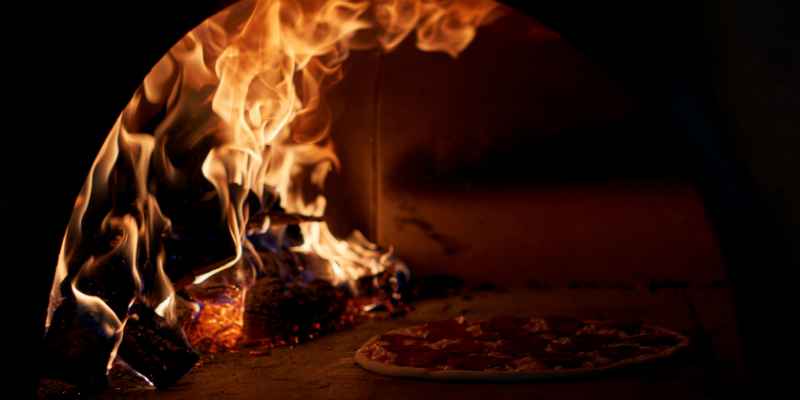To oven dry wood, place the wood in a conventional oven at a low temperature, around 200-250 degrees Fahrenheit, for several hours until the moisture content is reduced. Ensure that the wood is placed on a rack or elevated surface to allow for proper air circulation.
Monitor the wood closely to prevent any charring or overheating. Keep in mind that oven drying is not suitable for large pieces of wood and is best for small projects or smaller pieces of wood. It is important to follow safety precautions and guidelines when working with a hot oven.
Methods Of Oven Drying
Oven drying wood in a conventional oven is a simple and effective method. Preheat the oven to the desired temperature and place the wood inside for even drying.
Using a convection oven for drying wood provides faster and more uniform results. The fan in the oven helps in distributing the heat evenly, ensuring the wood dries thoroughly.
When comparing conventional and convection ovens for drying wood, convection ovens are preferred for their faster drying times and even distributions of heat. Conventional ovens may take longer and can lead to uneven drying of the wood.
Fastest Ways To Dry Wood
To oven dry wood, preheat the oven to around 215-225°F, ensuring good ventilation. Place the wood on a rack and let it dry for 2-6 hours until it reaches the desired moisture content. Keep the oven door slightly open to release moisture, and monitor the wood closely to prevent overheating or burning.
Sunny And Windy Locations
If you want to dry your wood as quickly as possible, try finding a sunny and windy spot to store it. The combination of sunlight and airflow will help to evaporate the moisture in the wood, speeding up the drying process. Find an area in your yard that receives plenty of direct sunlight throughout the day. It could be an open space or a spot near a south-facing wall. Make sure that the area is also well-ventilated, allowing the wind to pass through and carry away the moisture from the wood.
Using Tarps For Protection
If you don’t have access to a sunny location, don’t worry! You can still dry your wood by using tarps to protect it from the rain. Simply cover the woodpile with a tarp, ensuring it is securely fastened to prevent any water from seeping through. This will keep the wood dry and prevent any delays in the drying process caused by rain or moisture. Remember to also elevate the wood off the ground using pallets or bricks to allow air to circulate around it.
Alternative Drying Methods
Oven drying wood is a fast and efficient method to dry wood. By placing the wood in the oven at a specific temperature, you can speed up the drying process and reduce moisture content. It is an effective alternative to traditional air drying methods.
Alternative Drying Methods
When it comes to drying wood, there are various alternative methods that can be utilized to achieve the desired dryness. Whether you are lacking a kiln or want to explore different options, alternative drying methods such as sun drying and air drying can be effective. These methods are not only environmentally friendly but also allow for natural drying without the use of specialized equipment. Below, we will delve into these alternative drying methods using sun drying and air drying.
Sun Drying
Sun drying involves placing the wood in a sunny and windy location to expedite the drying process. If a sunny spot is not available, covering the wood with a tarp can protect it from rain while still allowing air circulation. Sun drying is an economical and efficient way to dry wood without the need for expensive equipment.
Air Drying
Air drying entails stacking the wood in a dry, well-ventilated area, allowing it to dry gradually over time. This method is beneficial as it does not require any specialized machinery and allows the wood to dry naturally. By providing proper air circulation, moisture is drawn out of the wood, resulting in a gradual and effective drying process.
Overall, both sun drying and air drying are valuable alternative methods for drying wood without the need for a kiln. By utilizing these natural techniques, you can effectively dry your wood while minimizing the use of specialized equipment and reducing environmental impact.
Temperature And Wood Drying
Oven drying wood is an effective method for reducing moisture content and preparing it for various crafting and woodworking projects. Understanding the impact of temperature on wood drying is crucial for achieving optimal results. Let’s delve into the significance of temperature and wood drying, and how it affects the process.
Wood Drying Temperature
When oven drying wood, the temperature plays a pivotal role in expediting the drying process. Maintaining the right temperature ensures efficient removal of moisture from the wood, leading to a desirable outcome. It is essential to set the oven temperature based on the type and thickness of the wood being dried.
Effects Of Temperature On Drying
The temperature directly influences the rate at which the wood loses moisture. Higher temperatures expedite the process, but excessive heat can lead to degradation of wood quality. Conversely, lower temperatures may prolong the drying time. By understanding the effects of temperature on wood drying, you can adjust the oven settings to achieve an optimal balance between efficiency and preserving wood integrity.
Risks And Precautions
To oven dry wood safely, always monitor temperature closely and avoid exceeding 212°F to prevent combustion. Prioritize adequate ventilation to remove moisture efficiently and reduce the risk of wood warping or cracking during the drying process. Use a reliable moisture meter to ensure the wood reaches the desired level of dryness.
Dangers Of Oven Drying
Oven drying wood can be a convenient method, but it is important to be aware of the potential risks involved. Understanding the dangers associated with this process can help you take the necessary precautions for a safe and successful outcome. Here are a few key hazards to keep in mind:
- Fire Hazard: The high temperatures required for oven drying wood pose a significant risk of fire. Always ensure that your oven is clean and free from any flammable materials before starting the drying process. It is also essential to monitor the wood closely to prevent overheating or ignition.
- Toxic Fume Emission: Some types of wood, particularly those treated with chemicals or finishes, can release toxic fumes when exposed to high temperatures. These fumes can be harmful if inhaled, so it is crucial to choose a well-ventilated area or use an oven with an exhaust system to minimize the risk.
- Wood Warping and Splitting: Rapid drying can cause wood to warp, crack, or split, ruining its quality and usability. It is crucial to follow the recommended drying temperature and time guidelines for the specific type of wood you are working with to avoid damage.
Safety Measures To Consider
When oven drying wood, implementing the following safety measures can help mitigate the potential risks and protect your safety:
- Use Proper Oven Tools: Invest in oven gloves and long-handled tongs to handle the wood safely and avoid burns or accidents.
- Ensure Adequate Ventilation: If possible, choose an oven with an exhaust system or open windows and doors to allow fresh air circulation and prevent the buildup of toxic fumes.
- Monitor Temperature and Time: Regularly check the oven temperature using a reliable thermometer and follow the recommended drying time for the specific type of wood. Avoid turning up the temperature too high to speed up the process, as this can result in damage.
- Remove Flammable Materials: Before placing the wood in the oven, make sure there are no flammable materials nearby that could pose a fire hazard.
- Keep a Fire Extinguisher Handy: In case of any unexpected fires, have a fire extinguisher nearby and know how to properly operate it.
By being aware of the risks involved in oven drying wood and implementing the necessary precautions, you can safely and effectively dry your wood to achieve the desired results without jeopardizing your safety or the quality of the wood.
Oven Drying Vs. Kiln Drying
Oven drying and kiln drying are two common methods used to dry wood effectively. Let’s explore the differences between these processes and the various benefits and drawbacks they offer.
Differences In Process
- Oven Drying: Involves placing the wood in a conventional or convection oven at a specific temperature to remove moisture.
- Kiln Drying: Utilizes specialized kilns to control temperature, humidity, and airflow for efficient wood drying.
Benefits And Drawbacks
| Method | Benefits | Drawbacks |
|---|---|---|
| Oven Drying | Cost-effective and accessible for small-scale projects | Potential for uneven drying and risk of over-drying |
| Kiln Drying | Consistent and controlled drying process resulting in high-quality wood | Requires specialized equipment and higher operational costs |
Best Practices For Oven Drying
Oven drying wood can be a quick and effective method to reduce moisture content, making it suitable for various woodworking projects. To ensure successful drying, it is essential to follow the best practices for oven drying wood.
Tips For Successful Drying
- Preparation is Key: Start by cutting the wood to the desired size and sealing the ends to prevent excessive moisture loss.
- Even Heat Distribution: Arrange the wood pieces evenly on the oven racks to ensure uniform drying.
- Monitor Temperature: Set the oven temperature between 150-200°F for optimal drying without causing damage to the wood.
- Regular Checking: Check the wood periodically to avoid over-drying, which can lead to cracking or warping.
- Patience is Virtue: Remember that the drying process may take several hours to days depending on the wood species and thickness.
Avoiding Common Mistakes
- Rapid Drying: Avoid using high oven temperatures to dry wood quickly, as it can result in uneven drying and damage.
- Moisture Content: Ensure the wood reaches the desired moisture content for your project by using a moisture meter.
- Proper Ventilation: Allow proper airflow within the oven to prevent excessive moisture buildup during the drying process.
- Overcrowding: Do not overcrowd the oven with wood pieces, as this can hinder air circulation and even drying.
- Safe Handling: Always wear protective gear when handling hot wood from the oven to avoid burns or injuries.

Frequently Asked Questions For How To Oven Dry Wood
What Is The Fastest Way To Dry Wood?
To dry wood quickly, place it in a sunny and windy spot or cover it with a tarp in a well-ventilated area.
How Do You Dry Wood Without A Kiln?
To dry wood without a kiln, you can sun dry in a shaded area or air dry in a well-ventilated space.
What Is The Oven Dry Method Of Timber?
The oven dry method of timber involves placing wood in an oven at a specific temperature to remove moisture and achieve a dry state. It is a quick and efficient way to dry wood for various purposes.
What Temperature Does Wood Dry At?
Wood generally dries at a temperature of around 100 to 140 degrees Fahrenheit.
Conclusion
Drying wood in an oven can be a fast and efficient way to achieve the desired moisture content. By following the proper steps, such as setting the temperature and time accordingly, you can oven dry wood effectively. Remember to always prioritize safety and ventilation during the process.
Additionally, consider alternative methods such as air or sun drying for smaller projects. With the right techniques, you can achieve perfectly dried wood for your woodworking needs.


